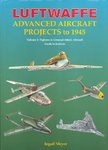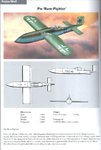delcyros
Tech Sergeant
Yes, if I recall correctly, the P.1101 wings are normal Me-262 serial prosuced wings with modifications for connecting with the fuselage.
But I think, what Adler also mentioned was that the P-1101 was avaiable for the US, they could study it more in detail (in order to understand the benefits and shortcomings of the swept back wing), while the 45 degrees swept back Me-262 HG-III was still in construction stage at wars end and the Me-262 HG-II, while completed (Werknummer 111 538), was unfortunately destroyed in a ground accident in early 1945. It should be noted that the US had some knowledge on their own research projects. There are documents which can proove that US scientists in early 1945 wrote an article to analyse Busemanns article about Pfeilflügeleffekt und die Herauschiebung der kritischen Geschwindigkeit (1937).
In the end it wasn´t successive because of the known shortcomings of the swept back wing design (which could be overcome with -for example- Me-262 slats, wing boundary layers and so on).
But I think, what Adler also mentioned was that the P-1101 was avaiable for the US, they could study it more in detail (in order to understand the benefits and shortcomings of the swept back wing), while the 45 degrees swept back Me-262 HG-III was still in construction stage at wars end and the Me-262 HG-II, while completed (Werknummer 111 538), was unfortunately destroyed in a ground accident in early 1945. It should be noted that the US had some knowledge on their own research projects. There are documents which can proove that US scientists in early 1945 wrote an article to analyse Busemanns article about Pfeilflügeleffekt und die Herauschiebung der kritischen Geschwindigkeit (1937).
In the end it wasn´t successive because of the known shortcomings of the swept back wing design (which could be overcome with -for example- Me-262 slats, wing boundary layers and so on).





